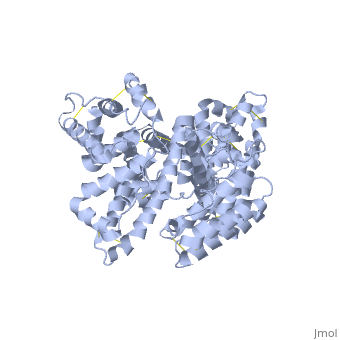Molecular Playground/Human Serum Albumin
From Proteopedia
HUMAN SERUM ALBUMIN (HSA)
Human serum albumin (HSA) is the most abundant protein in the blood plasma, amounting to about 35 to 50 grams per liter of serum. With a molecular weight of about 66.5 kDa, it functions mainly to maintain the pH and osmotic pressure of the blood and to transport a wide variety of endogenous and exogenous substances.
StructureHSA exists as a monomer that is comprised mostly of alpha helices. Each of the three homologous helical domains (domain I, domain II, domain III) is further divided into subdomains A and B (A=darker shade, B=lighter shade), which then form several hydrophobic pockets throughout the molecule. This multidomain structure of HSA allows it to bind many different classes of ligands at multiple sites. FunctionBeing the major protein in blood, HSA functions to maintain the osmotic pressure and the pH of the blood. Most importantly, it acts as a depot and carrier of various substances through the bloodstream. HSA does not carry a specific cargo, although it does have preference for fat-soluble substances as it can bury the water-insoluble molecules into its hydrophobic core. Here, we can see HSA with both myristate (a fatty acid) and aspirin (a common analgesic) bound to its hydrophobic pockets. HSA transports a wide variety of substances through the bloodstream including carbohydrates (e.g glucose), fatty acids (e.g. arachidonic acid), hormones (e.g. thyroxine, a thyroid hormone), and drugs (e.g. ibuprofen, an anti-inflammatory drug).
Role in pharmacokineticsThe affinity of HSA for various drugs affects their pharmacokinetics and efficacy. Although binding to HSA helps solubilize the drug in the plasma, too strong affinity to HSA limits the free/available forms of the drug, meaning that higher doses must be administered to achieve the desired efficacy of the drug in vivo. Removal of HSA in serum for biomarker studiesBecause HSA is very abundant in blood serum, most biomarker studies involving serum requires preliminary removal of HSA so that other non-abundant but otherwise important disease-indicating proteins can be detected. In our group, we exploit several properties of HSA in order to efficiently remove it from serum prior to biomarker analysis. These properties include its low isoelectric point (pI of about 4.7) due to a number of acidic residues, and its tendency to bind hydrophobic molecules through its hydrophobic pockets.
References[1] Fasano, M., Curry, S., Terreno, E., Galliano, M., Fanali, G., Narciso, P., … Ascenzi, P. (2005). The extraordinary ligand binding properties of human serum albumin. IUBMB Life, 57(12), 787–96. [2] Ghuman, J., Zunszain, P. a, Petitpas, I., Bhattacharya, A. a, Otagiri, M., & Curry, S. (2005). Structural basis of the drug-binding specificity of human serum albumin. Journal of Molecular Biology, 353(1), 38–52. [3] Björhall, K., Miliotis, T., & Davidsson, P. (2005). Comparison of different depletion strategies for improved resolution in proteomic analysis of human serum samples. Proteomics, 5(1), 307–17. |
| |||||||||||


